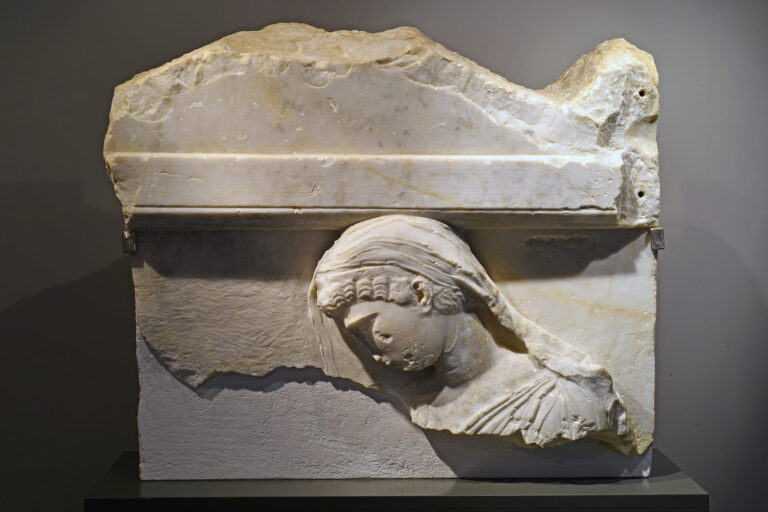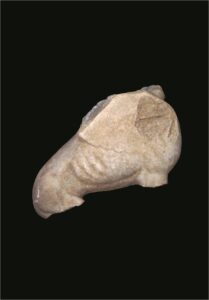Exhibits: Section 2
Section 2
Funerary Stele depicting a woman in sorrow
Funerary relief with the depiction of a woman, preserving her face and the upper part of her torso. The woman wears a mantle that covers her bowed hair and a chiton. Her lowered face is rather serene, showing a gentle sorrow. The upper part of the stele preserves the cornice of the pediment, decorated with a carved meander. It dates back to approximately the 5th century BC. It was found in Pentavrysos of the regional unit of Kastoria. It is the oldest and finest relief from Upper Macedonia, even though its workshop is unknown. The funerary stelai, mortuary monuments of the ancient Greek antiquity, provide us with important information concerning not only their synchronous societies, but also mortuary practices. The were used as grave markers for the remembrance of the dead. They were mainly made out of porolith, limestone and marble and they were usually decorated with colors. Their main side presented either the engraved name of the dead or/and the sculpturer or his/hers depiction in a sitting or a standing position accompanied by the dead’s favorite objects (weapons, jewelry etc.) or even other figures (such as relatives or deities).
Funerary marble Sphinx
Funerary marble Sphinx, preserving the torso, parts of the legs, the wings and the neck. She was sitting on her back legs. It is dated in approximately in 470 BC. And it was found in Pentavrysos, of the regional unit on Kastoria.
Sphinx is a mythical creature with the head of a woman and a winged body of a lion. It is frequently used throughout the Greek mythology according to which Sphinx was the daughter of the king Laios. She was standing nearby the entrance of Thebes, killing each one of those passing through the city, who could not solve her riddle: «which creature has four legs in the morning, two in the noon and three in the evening». Eventually, Oedipus answered correctly: it is man, who crawls during infancy, walks on two feet when grown, and leans on a cane when he’s old. After his answer, Oedipus became king of Thebes and Sphinx died.
Depictions of Sphinx were frequently used in Greek art and tradition. Especially during antiquity Sphinx possessed a chthonic character, in other words, she could protect from the evil. Therefore, her role within cemeteries, usually as a statue placed on top of a funerary stele, was to guard and protect the tomb.
Shield
Partially preserved shield, of the Macedonian type. It is dated in the 3rd century BC. It was found in Krepeni, Mavrochori. To its center lies part of in inscription: ΑΥ…ΤΟΣ.
The shield did not belong to the Macedonian army, and on the contrary it presents the inscribed name of the king Audoleon of Paeonia, a Greek name signifying “voice of a lion”. It is a unique and significant finding proving that Paeonians, whose land was located to the north of Macedonia and who were either enemies or vassals to the Macedonian kingdom depending on the era, imitated their powerful neighbour to the military equipment. It is probable that this shield is a relic from the period the Paeonian army was in Orestis, between 288-285 BC, when Audoleon and his ally King Pyrrhus of Epirus fought and defeated Demetrius Poliorcetes and together occupied Upper Macedonia.

